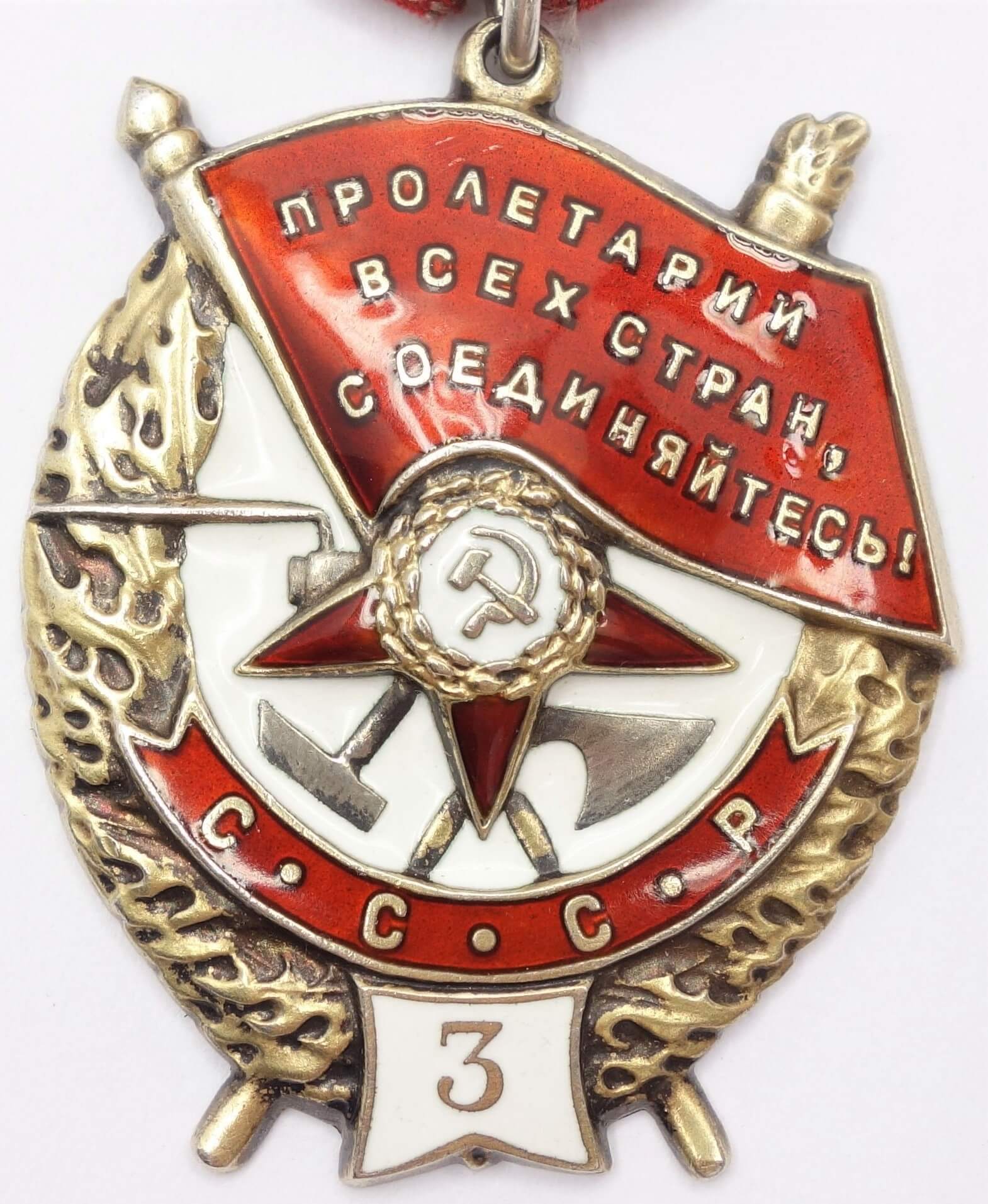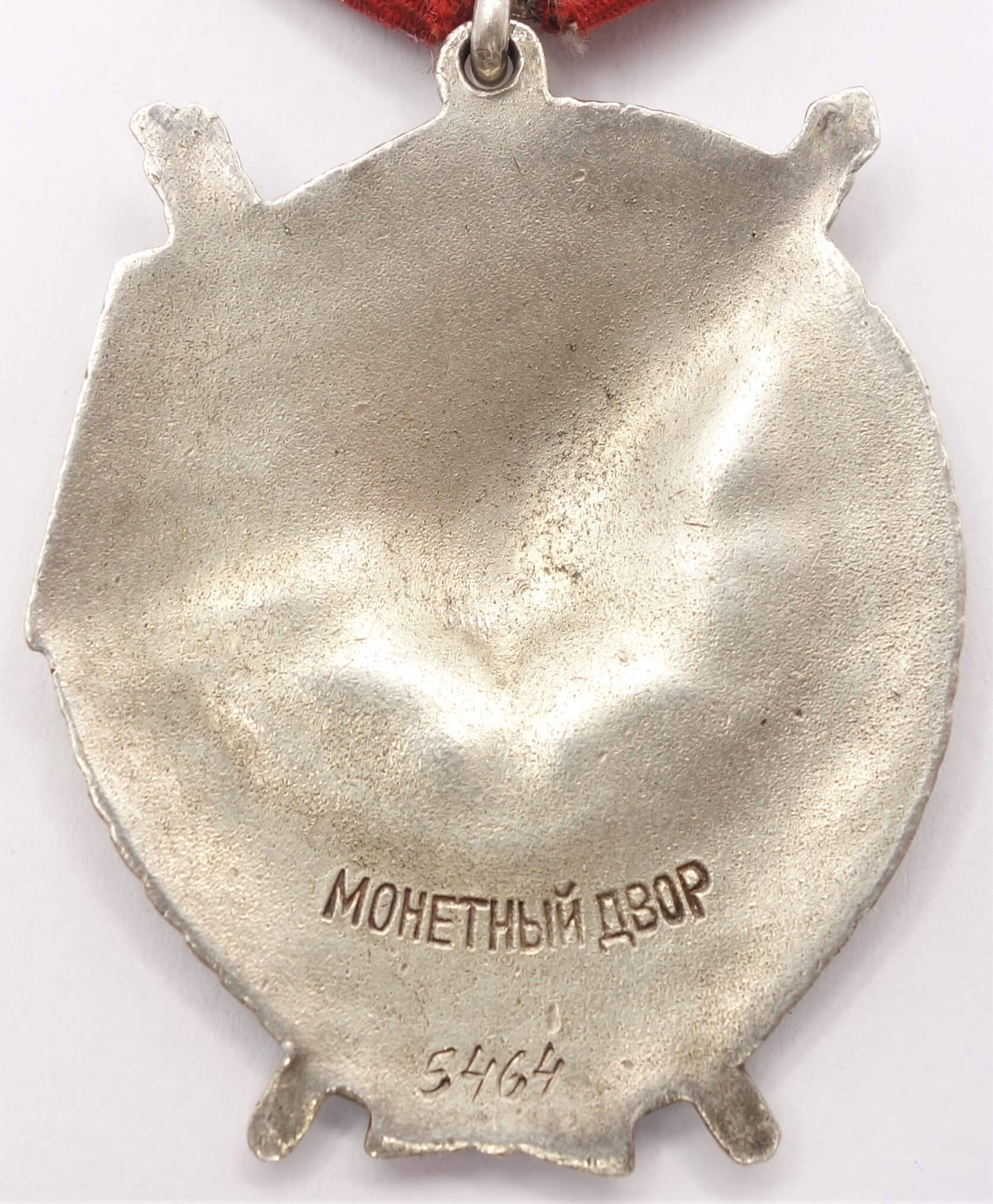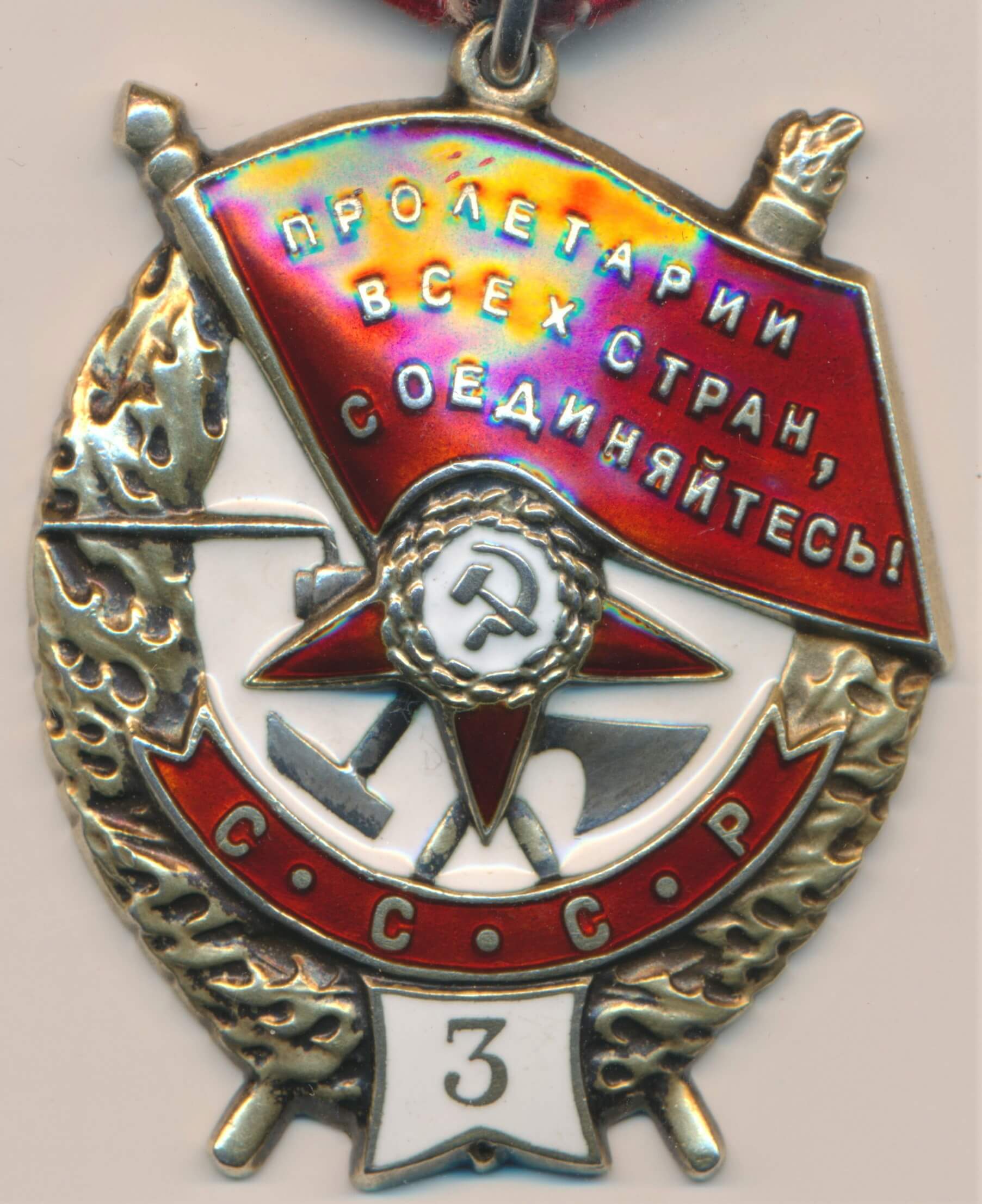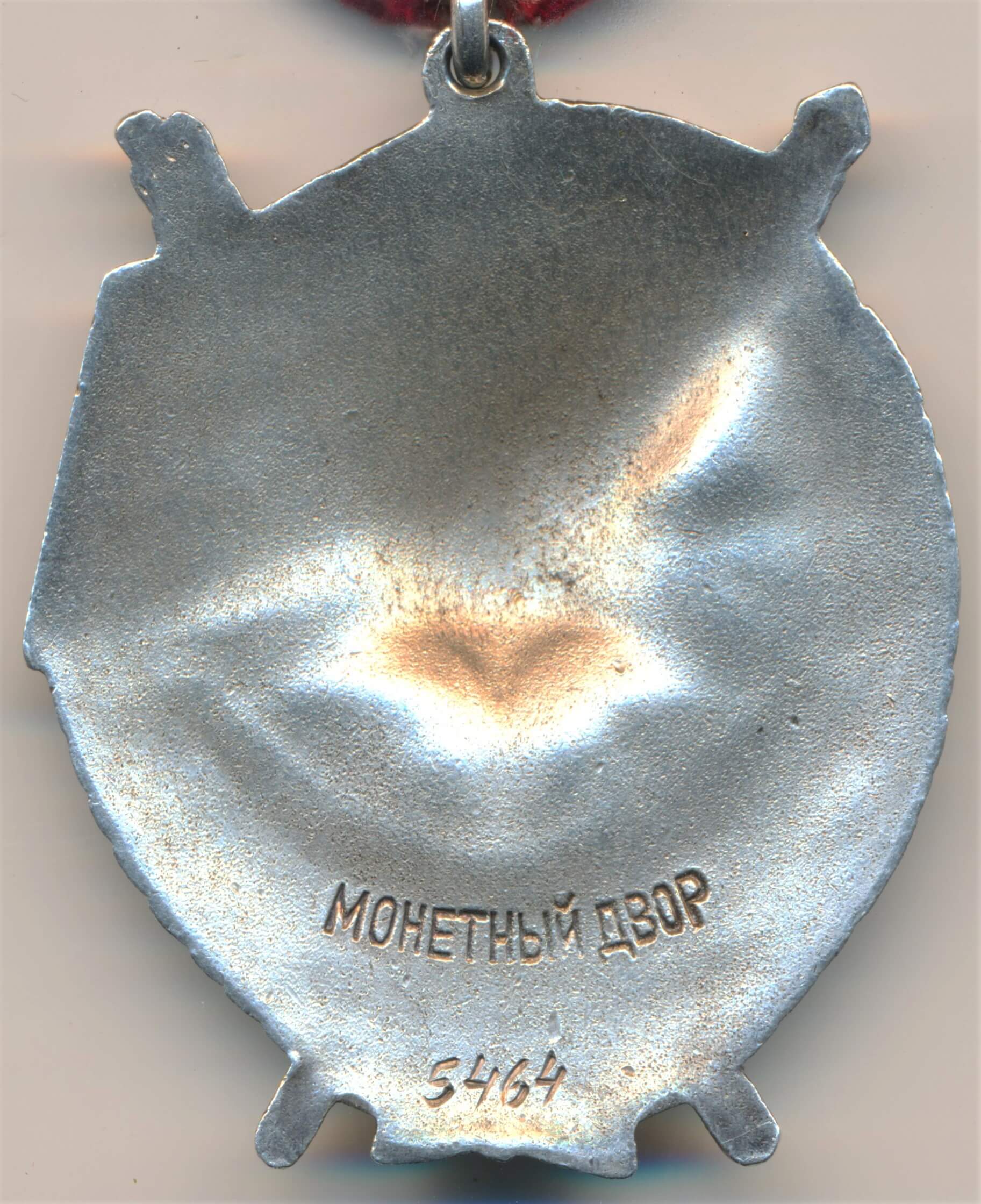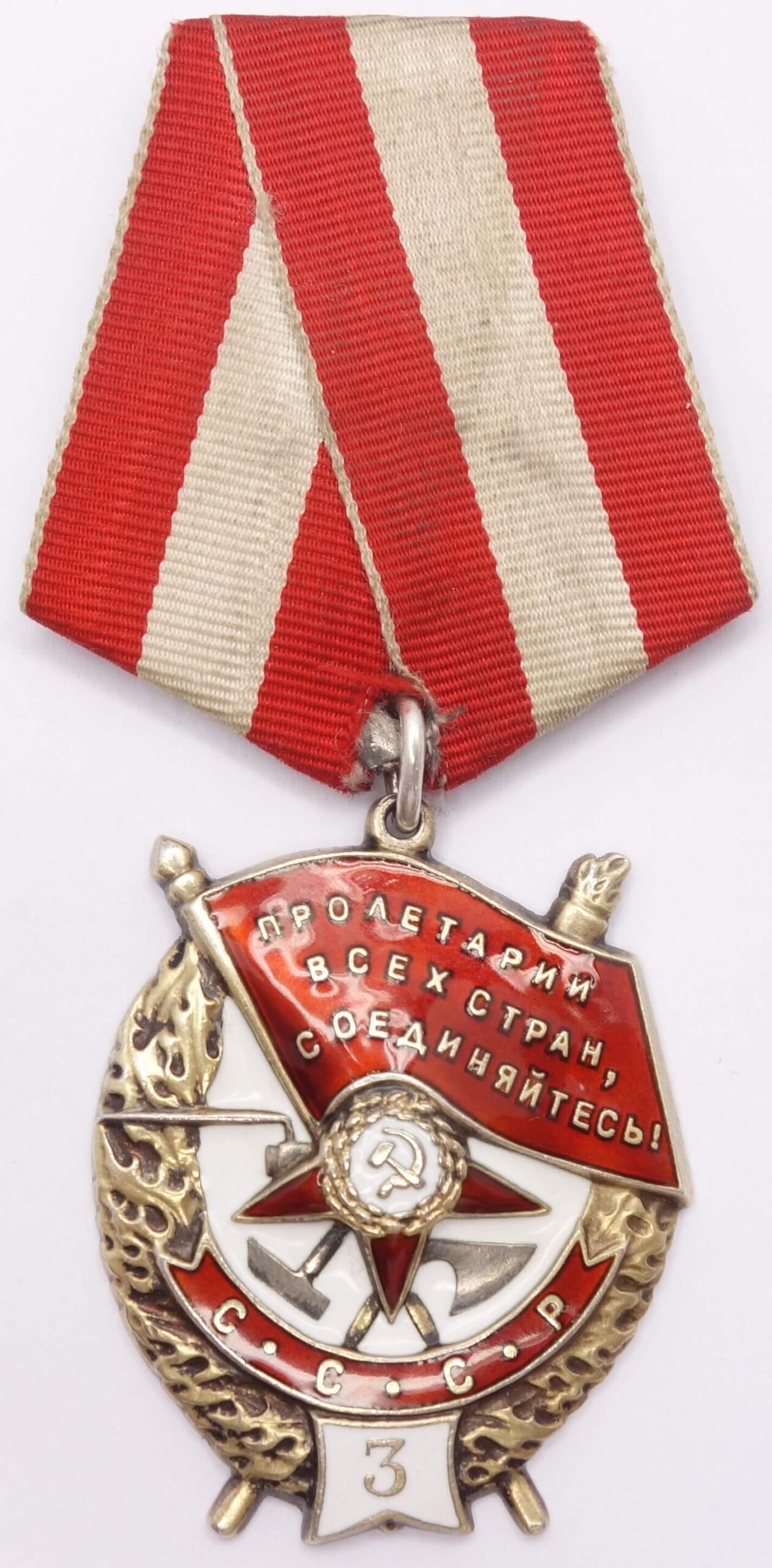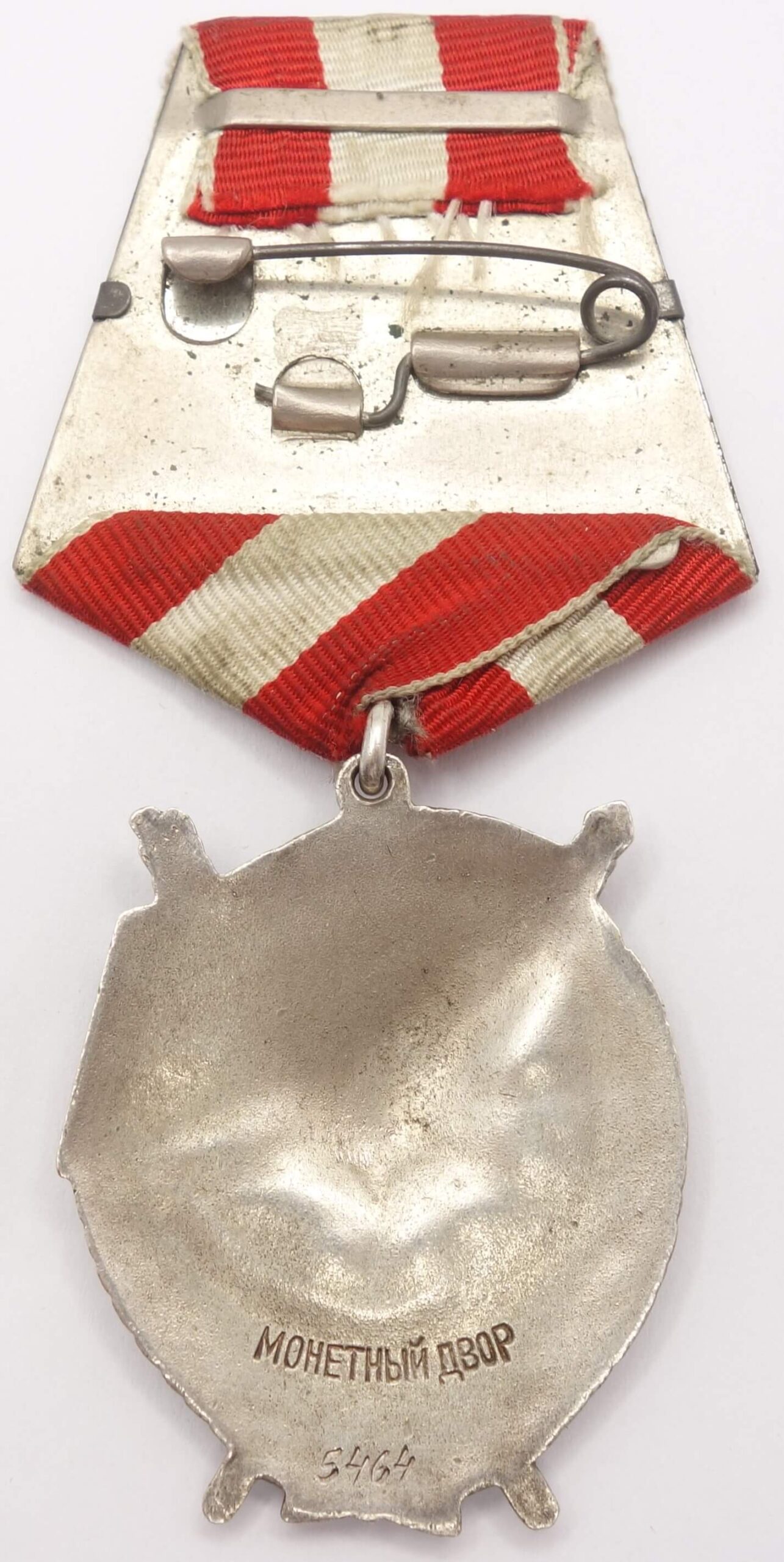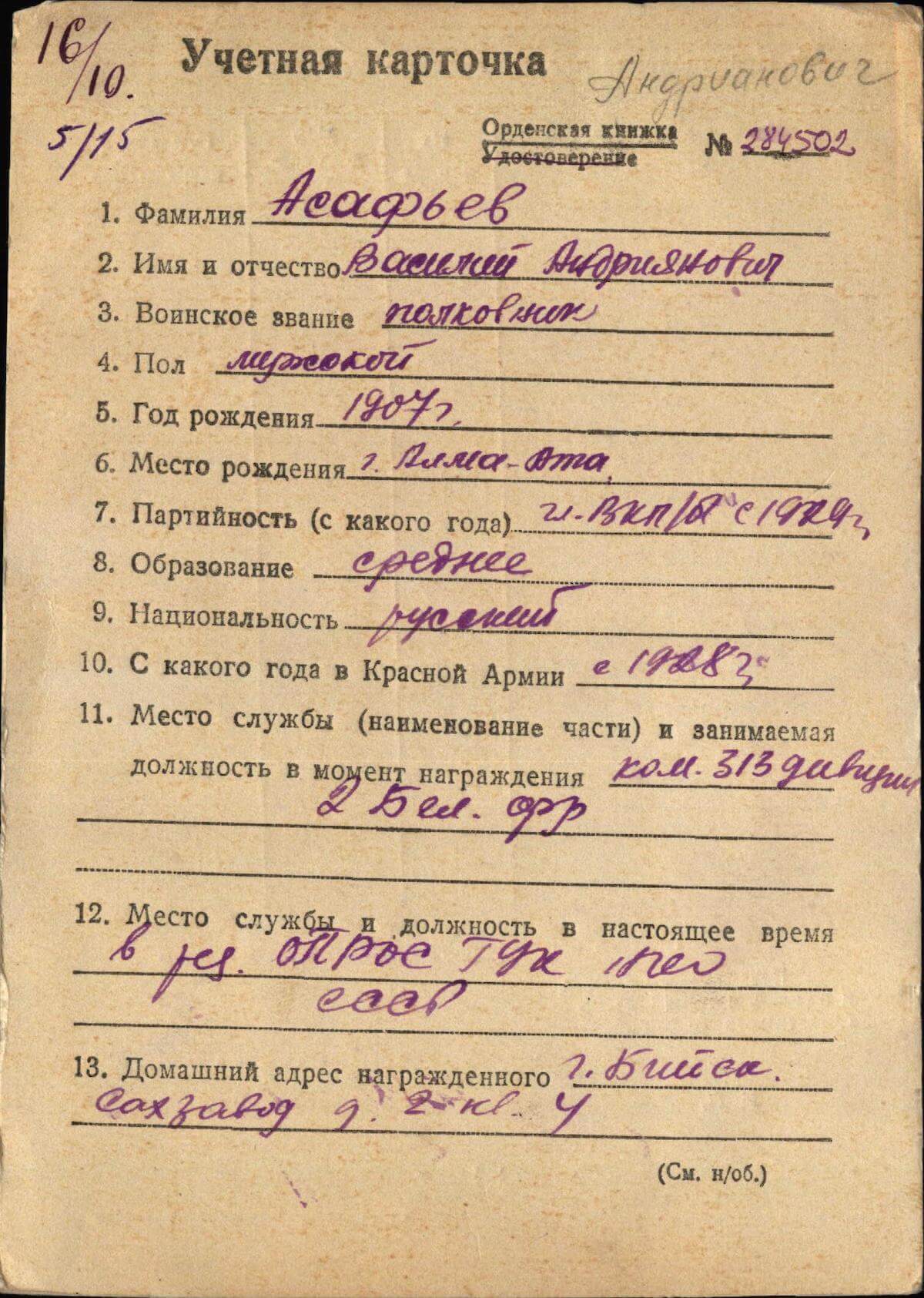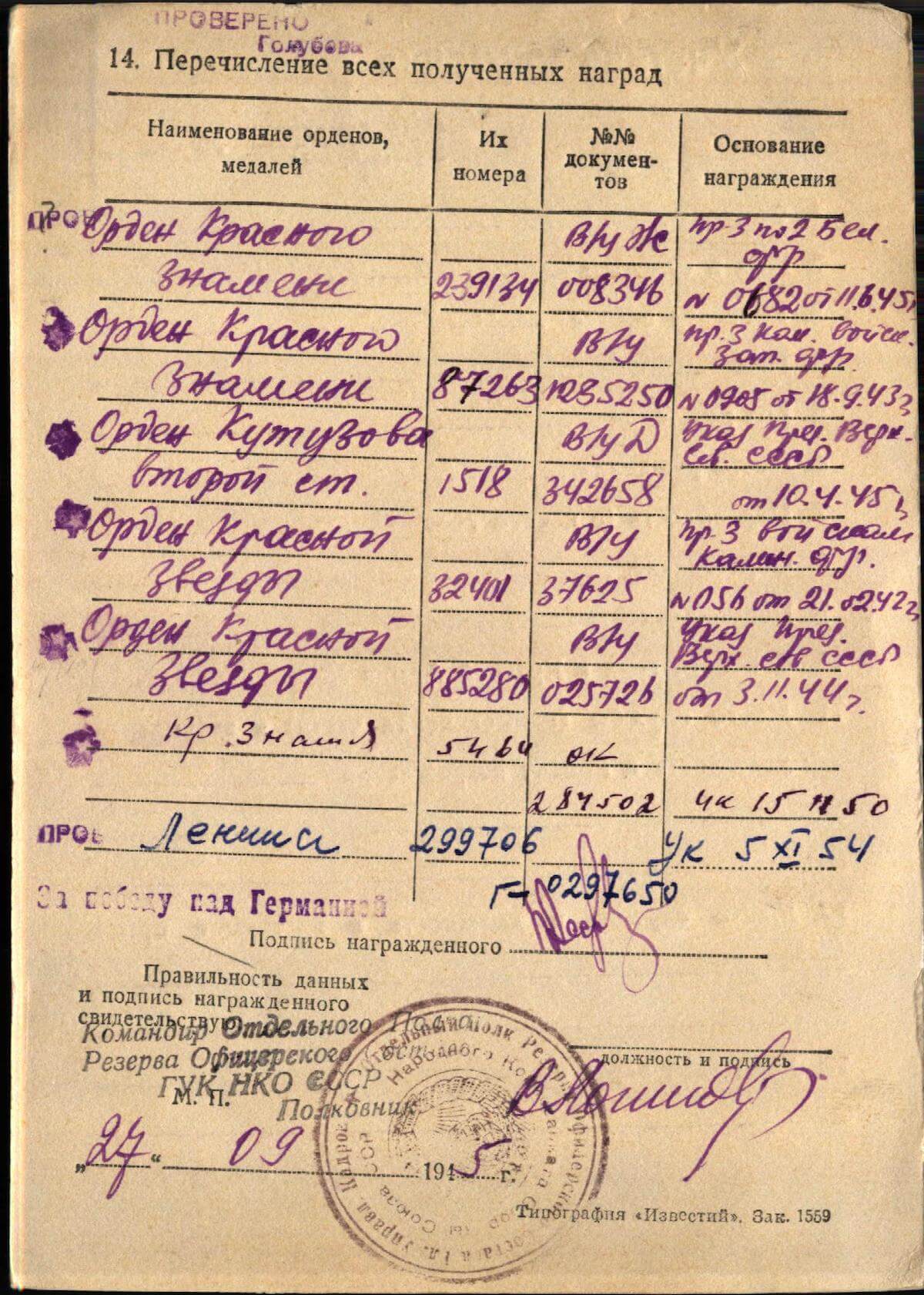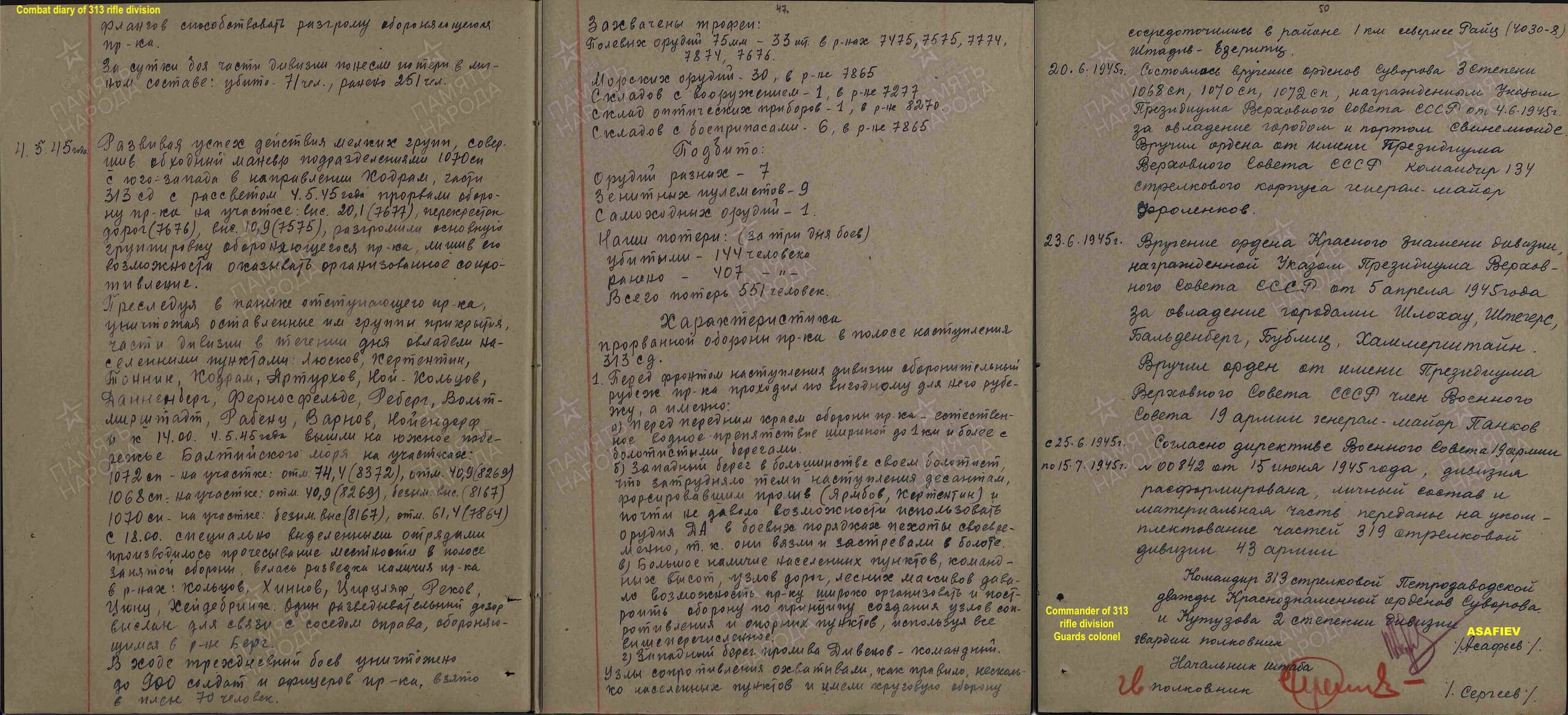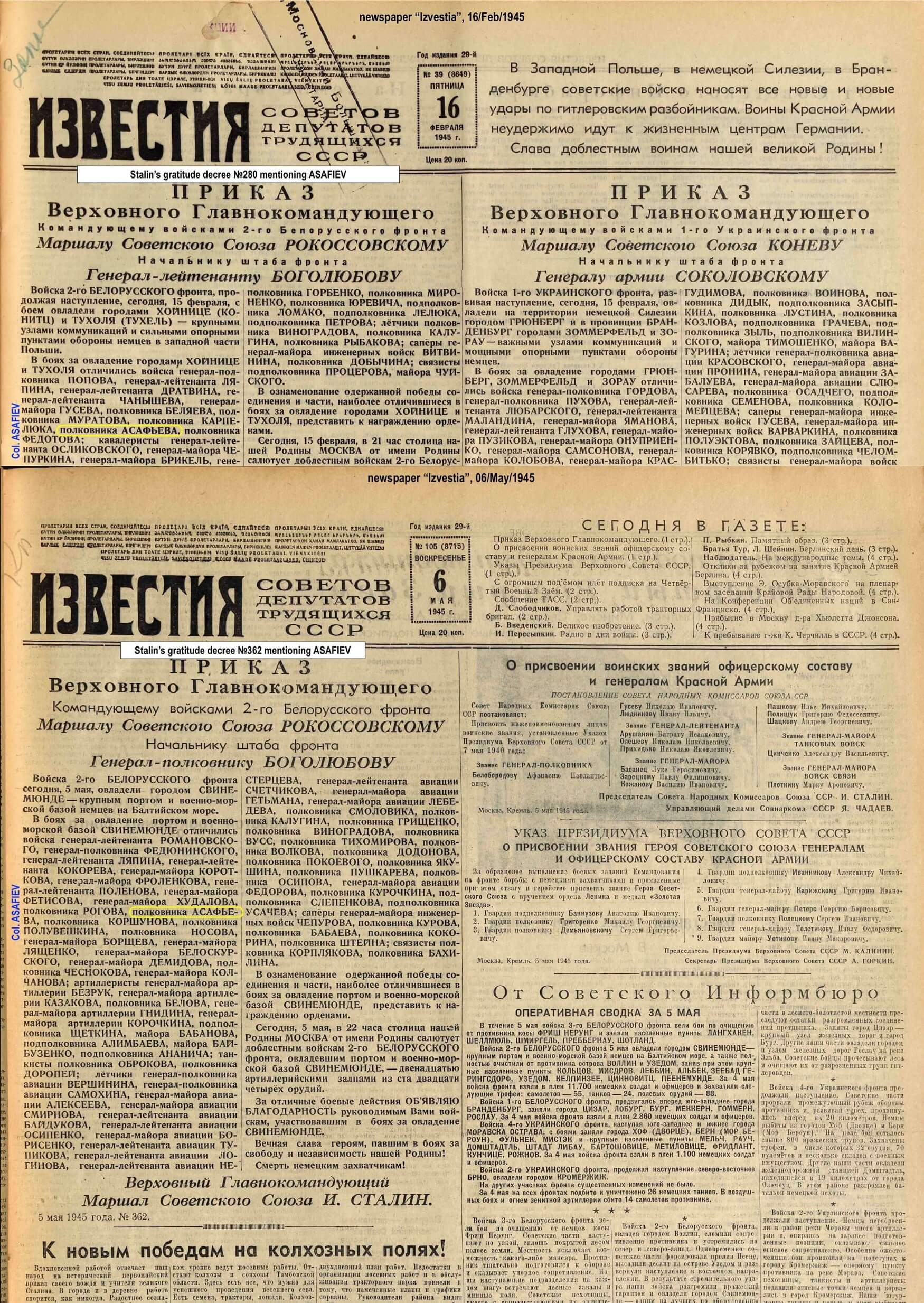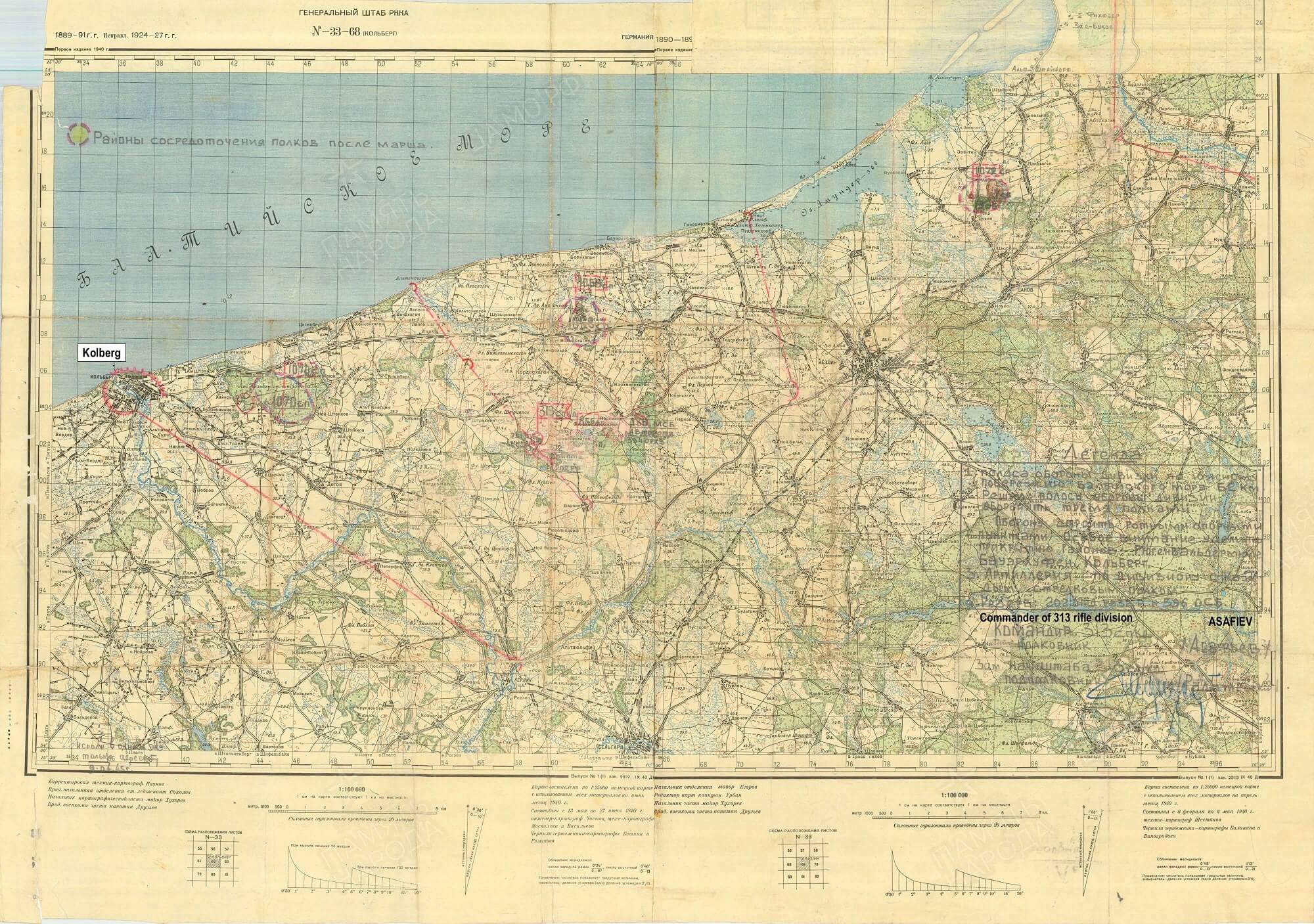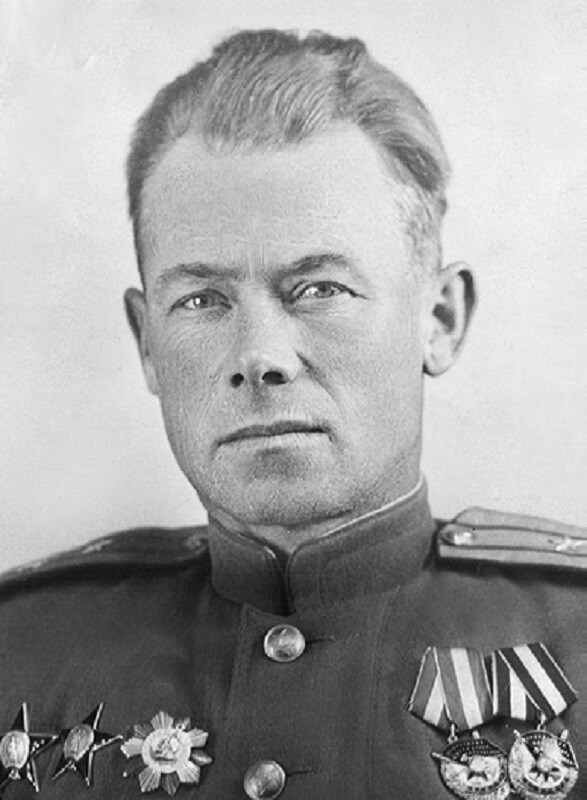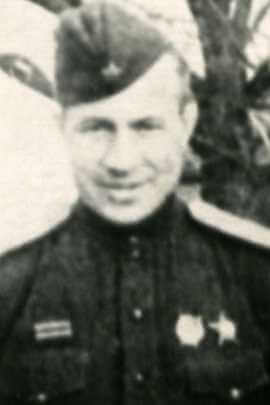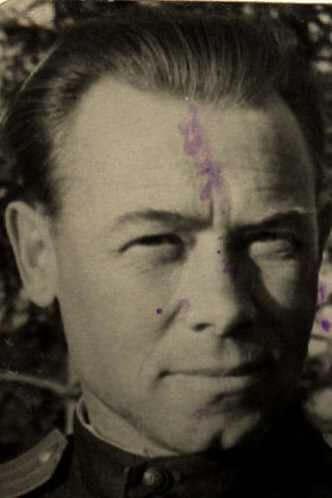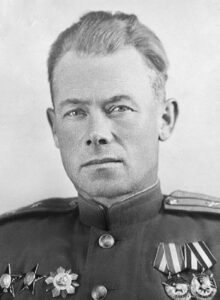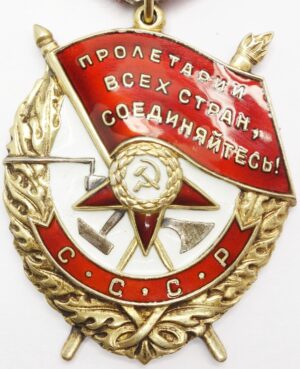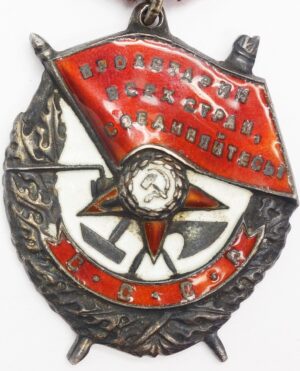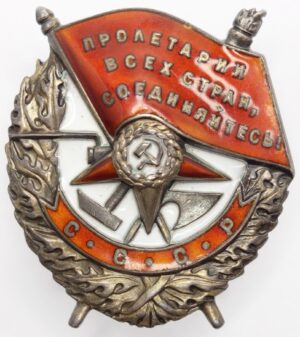Description
Order of the Red Banner 3rd award #5464
Awarded to Colonel Vasilij Andrianovich Asafiev (Василий Андрианович Асафьев)
Made of silver and enamels by the Moscow Mint. Measures 37.07 in width, 45.66 in height including its eyelet and weighs 24.6 grams without its suspension. A number ‘3’ is visible at the bottom of the front indicating this is the third Red Banner this awardee received. The minimum known serial number according to mondvor.rarod.ru for the range in this variation is 5236 and the maximum is 5434. As far as we can tell this piece is therefor the new highest known number in this range.
This original Order of the Red Banner in superb condition with crisp details. Even the center wreath and the torch of top show virtually no wear. The red and white enamels and essentially flawless without repairs and show a few minuscule contact marks on top only. Its reverse is in equally great condition and the order comes with its time period double layer steel suspension. Its connection ring has been cut.
A stunning piece, rare and hard to upgrade!
The translation of the record card can be read here
More information on Col. Asafiev can be found here, here and on wikipedia
Short Biography on Col. Asafiev:
Born on March 17, 1907 in the city of Verny (now Alma-Ata, Kazakhstan). Russian nationality
Military service
On October 1, 1928, he entered the United Central Asian Military School. V. I. Lenin in the city of Tashkent after which he was appointed commander of a platoon of the 5th Infantry Regiment of the 2nd Turkestan Infantry Division in the city of Fergana in June 1931. In May 1932 he was transferred as the head of the sniper team of the 299th Infantry Regiment of the 100th Infantry Division in the city of Shepetovka. From July 1933 he commanded a rifle and training company in the 4th Turkestan rifle regiment in the city of Vasilkov, Kyiv region. After that he became the commander of a rifle company and battalion in the 184th Turkestan rifle regiment. Since October 1938 he studies at the Military Academy of the Red Army. M. V. Frunze. After the 2nd year in April 1940, he was appointed deputy commander of the 164th Infantry Regiment of the 33rd Infantry Division PribOVO in the city of Vilkavishkis.
Great Patriotic War
With the outbreak of war, Captain Asafiev took command of the regiment and, as part of the same division of the 16th Rifle Corps of the 11th Army of the North-Western Front, participated with him in the border battle, covering the direction of Gumbinnen, Kaunas. For 17 hours on June 22, 1941, the division held its line of defense, only by the end of the day its units were forced to withdraw to the Pilviskiai area, where they took up defense at the Shesupe River. After that, by order of the command of the 11th Army, he retreated in an organized manner with battles to Kaunas and further to Jonava. On June 25, his units took part in a counterattack from the Jonava region to Karmelava and Kaunas. However, he did not bring the desired results, and the division was forced to further retreat to the area of Idritsa and Sebezh. From July 10, the division fought stubborn battles as part of the 27th Army of the North-Western Front, was surrounded twice, after which it broke through to Toropets, Sakhnovo, Loknya and further to Kholm. After leaving the encirclement, he was taken to the Valdai region for replenishment.
On October 14, 1941, Major Asafiev was appointed commander of the 940th Infantry Regiment of the 262nd Infantry Division. In early December, the division became subordinate to the Kalinin Front and fought as part of the 31st Army on the outskirts of the city of Kalinin. Commanding a regiment, Asafiev participated in the Kalinin offensive operation and the liberation of the city of Kalinin. Subsequently, the division as part of the army conducted offensive battles in the Rzhev direction. By the end of December, it reached the Volga River in the area northeast of Zubtsov. In the winter and spring of 1942, its units as part of the 31st and 39th (since January 16) armies took part in the Rzhev-Vyazemskaya offensive operation (in the Sychev direction) .
In June 1942, Lieutenant Colonel Asafiev was admitted to the position of deputy commander of the 262nd Infantry Division and fought with it as part of the 39th and 41st armies in the area of the city of Bely. In early July, they fought for 5 days uninterrupted, and managed to reach the main forces of the 41st Army, losing all the materiel of artillery, part of mortars and machine guns, and all vehicles. From July 19, 1942, the division was in the reserve of the Headquarters of the Supreme High Command. After replenishment in September, it became part of the 41st Army. At the end of November, its units participated in offensive battles to eliminate the Losmyansko-Krasno-Gorodsky enemy resistance center, providing the right flank of the army operating in the direction of Bely, Dukhovshchina. After that they fought in the area of the town of Bely .
In January 1943, Asafiev was appointed commander of the 74th Separate Rifle Brigade, which was part of the 22nd Army of the Kalinin Front. The brigade fought northwest of Rzhev and in March 1943 it participated in the Rzhev-Vyazemskaya offensive operation.
From May 5, 1943, Colonel Asafiev served as commander of the 56th Guards Rifle Division, which was formed near the city of Gzhatsk on the basis of the 74th and 91st Stalinist separate volunteer rifle brigades. In June 1943, Asafiev was transferred to the post of deputy commander of the 56th Guards Rifle Division. In August, the division, as part of the 19th Guards Rifle Corps, took part in the Spas-Demenskaya offensive operation and fought stubborn battles north of Spas-Demensk . At the end of August, its units crossed the Ugra River during the Yelninsko-Dorogobuzh offensive operation and rapidly pursued the enemy with decisive actions. In September the division broke through the enemy’s fortified defense line under st. Nezhoda and with a swift detour, it participated in the liberation of the city of Smolensk. In October-November, the division fought stubborn battles in the Orsha direction. At the end of December 1943, it was redeployed from near Orsha to the area of Lake Senchitskoye (southeast of Velikiye Luki ), where the division became part of the 2nd Baltic Front. In early January 1944, the division was transferred to the area of Lake Sviblo (southeast of Idritsa) where it fought heavy offensive battles in the area west of Novosokolniki (Maevo station), the city of Pustoshka and on the Velikaya River in order to expand the bridgehead northwest of Novorzhev. From mid-July 1944, as part of the 10th Guards Army of the 2nd Baltic Front, the division took part in the Rezhitsko-Dvina offensive operation.
On August 24, 1944, Colonel Asafiev was appointed commander of the 200th Rifle Division. In the second half of September, as part of the 3rd shock and 42nd armies, it successfully operated in the Riga offensive operation. In late November – early December 1944, the division was transferred to the 2nd Belorussian Front and entered the 70th Army. From January 18, 1945, as part of the 114th and 96th rifle corps, it participated in the East Prussian, Mlavsko-Elbing offensive operations to destroy the enemy’s Torn grouping and in the battles for the city of Tuchel. In mid-February Asafiev was removed from command and placed at the disposal of the Front’s Military Council.
On March 8, 1945 he was appointed commander of the 313th Infantry Division. As part of the 19th Army he participated in the East Pomeranian offensive operation for the liberation of the cities of Stolp and Gdynia. Then, until April 4, units of the division defended the western coast of the Baltic Sea in the area of the cities of Kezlin and Kolberg. From May 1 they participated in the Berlin offensive operation, in battles on the coast of the Baltic Sea near the island of Wolin. For the battles to capture the cities of Schlochau, Stegers, Hammarstein, Baldenberg, Bublitz, the division was awarded the second Order of the Red Banner (5.4.1945), for the capture of the city of Stolp – the Order of Suvorov 2nd class. (5.4.1945), and for the liberation of the city of Gdynia – the Order of Kutuzov 2nd class. (17.5.1945).
During the war, Divisional Commander Asafiev was personally mentioned five times in thanksgiving orders of the Supreme Commander-in-Chief [see picture gallery].
Post-war period
- Since July 1945, he was at the disposal of the Military Council of the SGV.
- Since October 1945 – Deputy Commander of the 126th Infantry Division of the Tauride Military District.
- From March 1946 – Deputy Commander of the 263rd Rifle Division.
- In October 1946 he was transferred as a lecturer in the Department of Tactics of the Military Transport Academy of the Red Army. L. M. Kaganovich in Leningrad.
- Since January 1947 – the military commissar of the Kamensky RVC of the Kirovograd region.
- From May 15 to November 25, 1950, he was trained at the Kuibyshev advanced training courses for officers of local military authorities.
- In November 1951, he was appointed military commissar of the Alexandria RVC of the Kirovograd region.
- On August 31, 1954, Colonel Asafiev was dismissed due to illness.
Awards
Order of Lenin (03.11.1953)
three orders of the Red Banner (09/18/1943, 06/11/1945, 06/20/1949 [sic])
Order of Kutuzov II degree (04/10/1945)
two orders of the Red Star (21.02.1942, 03.11.1944)
medals including:
For the victory over Germany in the Great Patriotic War of 1941-1945.
For the capture of Koenigsberg
Gratitudes of the Supreme Commander-in-Chief in which V. A. Asafiev is noted.
For the capture of the cities of Chojnice (Konitz) and Tuchola (Tuchel) – large communications centers and strong strongholds of the German defense in the western part of Poland. February 15, 1945. No. 280.
For the capture of the city of Stolp – an important junction of railways and highways and a powerful stronghold of the German defense in Northern Pomerania. March 9, 1945. No. 297
For the capture of the cities of Gniew (Mewe) and Starogard (Preussish Stargard) – important strongholds of the German defense on the outskirts of Danzig. March 7, 1945. No. 294.
For taking by storm the city of Gdynia , an important naval base and a major port on the Baltic Sea. March 28, 1945. No. 313.
For the capture of the city of Swinemünde – a major port and naval base of the Germans on the Baltic Sea. May 5, 1945. No. 362.
(source)
In the picture gallery 3 scans of images can be found together with a combat map of the map 313th Rifle Division of May 1945, 2 newspapers mentioning Asafiev and his signature on a combat diary
Please contact us with questions
